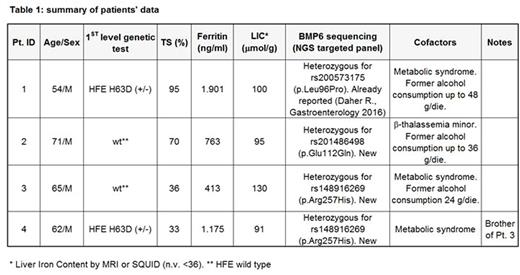Abstract

Background: Hereditary Hemochromatosis (HH) is a genetically heterogeneous disorder caused by mutations in at least 5 different genes (HFE, HJV, TFR2, SLC40A1, and HAMP) involved in the production and function of the liver hormone hepcidin, a key regulator of iron metabolism. Nevertheless, patients with a HH-like phenotype that remains unexplained, despite extensive sequencing of the known genes, are not infrequently seen at referral centres, implicating the role of still unknown genetic factors. A compelling candidate is Bone Morphogenetic Protein 6 (BMP6), a member of TGFb superfamily, whose expression is stimulated by increased iron stores in the liver. BMP6 acts as a major activator of the BMP-SMAD signalling pathway, ultimately leading to the upregulation of hepcidin gene transcription. Indeed, early this year French Authors have described 3 heterozygous missense mutations in BMP6 (p.Pro95Ser, p.Leu96Pro, and p.Gln113Glu) in 6 unrelated patients with mild to moderate, late onset, unexplained iron overload (Daher R, Gastroenterology 2016).
Methods: we recently updated our next generation sequencing (NGS)-based second level genetic test for the molecular diagnosis of non-HFE HH (Badar S, Am J Hematol 2016), by adding a number of novel potential candidate genes, including BMP6, to the panel of the 5 known HH genes. This test was applied to 38 patients evaluated at our tertiary referral centre for iron disorders, because of an unexplained iron overload phenotype.
Results: we found 3 heterozygous missense mutations in BMP6 gene in 4 patients with unexplained, late-onset, iron overload, from 3 different families. Their relevant clinical data are summarized into Table 1. Of note, 1 mutation (p.Leu96Pro) was the same recently described by Daher et al. and proven to be functional. The other two mutations (p.Glu112Gln, p.Arg257His) were novel, predicted damaging by bioinformatic tools, and both located in the pro-peptide domain, known to be crucial for appropriate BMP6 processing and secretion. They were further studied by in silico modelling, based on the available 3D structure of the TGFb, which also resulted to be consistent with their pathogenetic role.
Conclusions: to the best of our knowledge, our results provide the first independent confirmation of the likely causal role of BMP6 mutations in late onset, moderate iron overload phenotype, unrelated to mutations in the established 5 HH genes.
No relevant conflicts of interest to declare.
Author notes
Asterisk with author names denotes non-ASH members.

This icon denotes a clinically relevant abstract


This feature is available to Subscribers Only
Sign In or Create an Account Close Modal